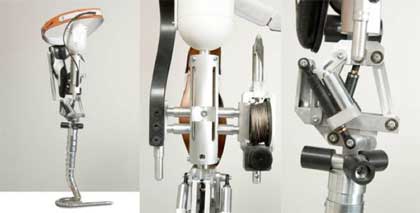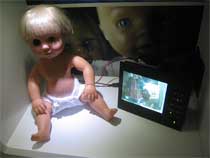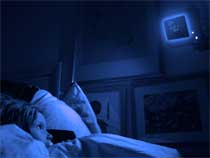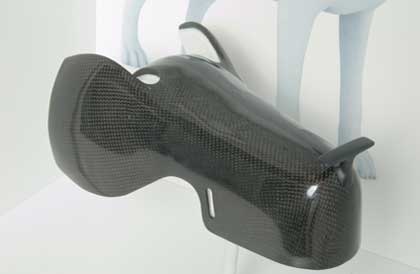The Science of Spying, an exhibition currently running at the Science Museum in London. Part 1 of my report.
After having completed a series of challenges, visitors enter the OSTECK Future Lab and Escape. The room displays an array of surveillance and counter-surveillance prototypes likely to be used by spies in a speculative near future. The pieces, created by some of the most famous UK-based (interaction) designers, are clever and sometimes humorous but they also provide us with more opportunities to think about the implications of future spy and surveillance products and how far we’d want them to invade our lives.
A first selection of the gadgets (rest will come later!)
 Noam Toran and Nick Williamson propose to replace your leg with a super-powered limb. You’d run faster, jump higher, climb sheer walls, the tail-like end would enable you to grip and wrap around things like an octopus, or dangle from tall buildings.
Noam Toran and Nick Williamson propose to replace your leg with a super-powered limb. You’d run faster, jump higher, climb sheer walls, the tail-like end would enable you to grip and wrap around things like an octopus, or dangle from tall buildings.
Today normal people use plastic surgery to change their appearance, spies might want to take a more extreme step in order to improve their physical capabilities and ensure they get ahead in business. They would purposefully amputate their limbs in order to be refitted with such sophisticated prosthetics.
Other replacement limbs could give you weirder and wilder skills. What gadget-arms or gadget-legs would you choose?

 James Auger and Jimmy Loizeau contributed to the show with a dark-corner cam that watches where children dare not look – under the bed, inside the wardrobe, behind the curtains… wherever scary monsters might lurk. You wire a camera into each of your friendliest toys. They watch the dark; you watch your monitor.
James Auger and Jimmy Loizeau contributed to the show with a dark-corner cam that watches where children dare not look – under the bed, inside the wardrobe, behind the curtains… wherever scary monsters might lurk. You wire a camera into each of your friendliest toys. They watch the dark; you watch your monitor.
But would this make the night any safer?

Another speculative gadget is the electromagnetic sniffer muzzle that converts electromagnetic fields into tickling electrical sensations that tell the trained dog if bugs or cameras are nearby. Sniffer dogs could identify and patrol precious surveillance-free zones, keeping ordinary people out.
The emf antenna is wired into the smell part of the brain to give the dog an extra sense (replacing smell with emf sensitivity), it picks up on research being done into technologically mixing senses. This principle is called sensory
substitution), it involves the replacement of one sensory input (vision, hearing, touch, taste or smell) by another, while preserving some of the key functions of the original sense. In particular, research in this area aims at providing some equivalent of vision via hearing or touch, or some equivalent of hearing via vision or touch. Blindness and deafness are generally considered to be among the sensory disabilities that have the greatest impact on everyday life, and the quest for good sensory substitution devices or prostheses for blindness and/or deafness therefore presents a great challenge.” That one was designed by Fiona Raby and Anthony Dunne.
Images: limb from Noam Toran; emf muzzle from Tony Dunne, CCTV in the dark (the one on the right) courtesy of James Auger.
The Science of Spying runs at the Science Museum in London until September 2007 and will then tour abroad.
